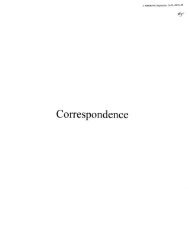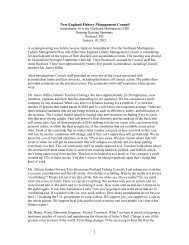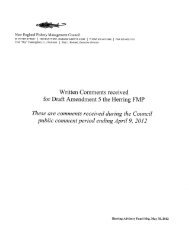Smooth Bottom Net Trawl Fishing Gear Effect on - New England ...
Smooth Bottom Net Trawl Fishing Gear Effect on - New England ...
Smooth Bottom Net Trawl Fishing Gear Effect on - New England ...
You also want an ePaper? Increase the reach of your titles
YUMPU automatically turns print PDFs into web optimized ePapers that Google loves.
NOAA/NMFS Unallied Science Project, Cooperative Agreement NA16FL2264 December 2005<br />
<str<strong>on</strong>g>Smooth</str<strong>on</strong>g> <str<strong>on</strong>g>Bottom</str<strong>on</strong>g> <str<strong>on</strong>g>Net</str<strong>on</strong>g> <str<strong>on</strong>g>Trawl</str<strong>on</strong>g> <str<strong>on</strong>g>Fishing</str<strong>on</strong>g> <str<strong>on</strong>g>Gear</str<strong>on</strong>g> <str<strong>on</strong>g>Effect</str<strong>on</strong>g> <strong>on</strong> the Seabed:<br />
Investigati<strong>on</strong> of Temporal and Cumulative <str<strong>on</strong>g>Effect</str<strong>on</strong>g>s BKAM/CR<br />
3.4 Benthic Results and Discussi<strong>on</strong><br />
Benthic infaunal grab samples from Mud Hole and Little Tow produced 58,600 individuals of<br />
238 species. Raw data for stati<strong>on</strong> replicates and sampling coordinates are provided in Appendix<br />
3.4-A. The fauna was diverse and abundant, typical of that seen in other areas in Massachusetts<br />
Bay. The sediments influenced species compositi<strong>on</strong> and distributi<strong>on</strong>. Some species were more<br />
abundant in the fine sands with high levels of silt/clay while others were more comm<strong>on</strong> in the<br />
medium sand sediments with lower levels of silt/clay. Unlike samples from our 2001 trawl<br />
study, where the dominant species in 49 of the 67 grab samples analyzed was the small spi<strong>on</strong>id<br />
polychaete, Pri<strong>on</strong>ospio steenstrupi, there were several other species that were more abundant in<br />
the 2002 grabs particularly at Little Tow. Species dominance, based <strong>on</strong> total counts for a species<br />
from three replicate samples at each stati<strong>on</strong> (Tables 3.4-1 and 3.4-2), was shared am<strong>on</strong>g five<br />
species (Pri<strong>on</strong>ospio stennstrupi, Spio limicola, Nucula delphinod<strong>on</strong>ta, Phor<strong>on</strong>is architecta, and<br />
Dipolydora socialis). Figures 3.4-1 through 3.4-4 are graphs of average individuals per grab of<br />
key species in the paired c<strong>on</strong>trol and trawled lanes for Mud Hole and Little Tow over the study<br />
period. There was an apparent shift in dominance at many sites from Pri<strong>on</strong>ospio steenstrupi in<br />
2001, to Spio limicola in 2002. Pri<strong>on</strong>ospio remained an important comp<strong>on</strong>ent of the fauna<br />
where Spio dominated, and was typically the sec<strong>on</strong>d most abundant species except at some sites<br />
in Little Tow.<br />
3.4.1 Mud Hole Baseline Results (July 2002 pre-chr<strong>on</strong>ic trawling)<br />
Benthic grab samples taken in July from the trawled lanes at Mud Hole averaged 836 individuals<br />
of 60 species. These parameters were not significantly different from the c<strong>on</strong>trol lanes (63<br />
species, 1043 individuals).<br />
At both trawled stati<strong>on</strong>s (MH1B, MH3B) Spio limicola was the dominant species. Pri<strong>on</strong>ospio<br />
and Nucula delphinod<strong>on</strong>ta were the next most abundant species at MH1B. Dipolydora socialis<br />
and Pri<strong>on</strong>ospio were the sec<strong>on</strong>d and third most numerous species at MH3B. The small bivalve,<br />
Nucula was present in good numbers at MH1B (179), but did not feature <strong>on</strong> the dominant species<br />
list at MH3B (38 individuals).<br />
Spio limicola was also the dominant organism (30.2 – 34%) at the c<strong>on</strong>trol lane stati<strong>on</strong>s prior to<br />
chr<strong>on</strong>ic trawling, with Pri<strong>on</strong>opsio being the next most abundant organism (13.9 – 18.9%),<br />
followed by Dipolydora socialis (6.7 – 5.8). The bivalve Thyasira was comm<strong>on</strong> at both c<strong>on</strong>trol<br />
lane stati<strong>on</strong>s. Again, Nucula delphinod<strong>on</strong>ta was present in good numbers, 207 found in the north<br />
(MH2B), but not at the southern site (MH4B). Most of the remaining dominants were<br />
polychaetes, comm<strong>on</strong> to both c<strong>on</strong>trol lane stati<strong>on</strong>s.<br />
There was c<strong>on</strong>siderable overlap in the remaining species listed as dominants in both the trawl<br />
lanes and c<strong>on</strong>trol lanes. Both northern lanes (MH1B-trawled and MH2B-c<strong>on</strong>trol) where Nucula<br />
was abundant had 10 to 20% more medium sand and less fine sand than the southern Mud Hole<br />
stati<strong>on</strong>s.<br />
43







